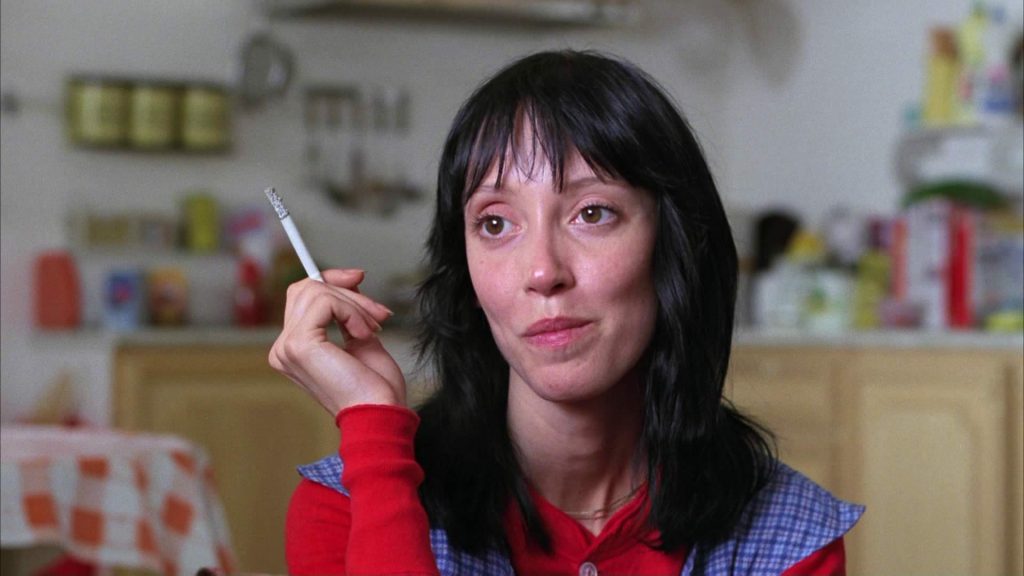Her performance was perhaps misunderstood at the time, just as the narrative surrounding her life would be later.

If Stanley Kubrick’s “The Shining” was a twist on the centuries-old Gothic horror genre, there was no one better suited to play a modern Gothic heroine than Shelley Duvall. Duvall, who died Thursday at 75, was in her late 20s when she shot the role of Wendy Torrance, put-upon wife of blocked writer Jack (Jack Nicholson). The pair have holed up with their young son in the Overlook Hotel, working as winter caretakers.
But something evil is afoot. The Overlook is less hotel than haunted house, saddled with the weight of inexplicable and violent history. Wendy is virtually trapped there, a small woman often alone in a rambling, dangerous building full of secrets. It might be more accurate to call the Overlook a monster, one that pushes its monstrousness onto its inhabitants. And it is Wendy, not Jack, who successfully resists in the end.
The Gothic heroine, the woman trapped in the menacing haunted home, must exhibit courage in the face of danger, remaining resolute while also being susceptible to the evil that lurks around every corner. Without that tension, we wouldn’t be kept in suspense. In the film, Duvall is waifish, eyes wide, hair flat and scraggly, and it’s hard not to believe she’s going to die. Her only objective is to save her son, Danny, from his father, who — we learn early on — previously broke Danny’s arm in an alcoholic rage. This evil she is fighting is malevolent and abusive and real, a threat she has seen in action before, only now it carries an ax.
The Wendy of Kubrick’s 1980 movie is a different kind of woman than the Wendy of Stephen King’s earlier novel — she’s more vulnerable, more frightened. King complained that the movie’s version was “basically just there to scream and be stupid and that’s not the woman that I wrote about.” Duvall was cited as a weak point in many of the film’s mixed reviews and nominated for a Razzie for worst actress.

But plenty able to scream. Speaking with the critic Roger Ebert in 1980, Duvall revealed nuanced feelings about the shoot, likening the experience to primal scream therapy. “In my character I had to cry 12 hours a day, all day long, the last nine months straight, five or six days a week,” she explained. But “I went home very contented,” she added. “It had a very calming effect. During the day I would have been absolutely miserable.”
Even at her relatively young age, Duvall had made a name for herself in the movies of Robert Altman, like “McCabe and Mrs. Miller,” “Nashville” and “3 Women,” working in the director’s loose, improv-heavy style. Kubrick, by contrast, was exacting and relentless, shooting many dozens of takes, stretching his actors to their breaking point. Duvall told David Hughes, the author of “The Complete Kubrick,” that the stress of the lengthy production had pushed her into ill health. (Her boyfriend, Paul Simon, had also broken up with her just before production began.)
In 2002, Duvall retired from show business and seemed to drop out of the public eye entirely. She resurfaced in a rare 2016 television interview on an episode of “Dr. Phil” titled “A Hollywood Star’s Descent Into Mental Illness: Saving The Shining’s Shelley Duvall.” In it, she seemed genuinely troubled, and the show generated copious backlash.

It also led to questions about the effects of lingering trauma from her experience on the set of “The Shining.” (Her Razzie nomination was rescinded in 2022, with the organization noting in a statement that “we have since discovered that Duvall’s performance was impacted by Stanley Kubrick’s treatment of her throughout the production.”) And thematically, that fit: Duvall was once again the vulnerable woman living in apparent isolation — a small Texas hill country town that she moved to in the 1990s. Where had she gone? Why? Who knew what monsters were still stalking her?
In April 2024, however, less than two months before her death, Duvall granted an interview to The New York Times. Among the many topics of conversation was “The Shining,” of which she still had fond if complicated memories. But for her, the real lurking evil wasn’t Kubrick, but the broader Hollywood establishment, which she believed had dismissed and forgotten her.
“How would you feel if people were really nice, and then, suddenly, on a dime, they turn on you?” she asked. “You would never believe it unless it happens to you. That’s why you get hurt, because you can’t really believe it’s true.”
It’s hardly a new tale for Hollywood heroines, who have a long history of being driven out of the industry by one monster or another. Yet though she missed her life in Hollywood, Duvall faced her future a lot like a Gothic heroine would. Interviewers in the post-“Dr. Phil” period noted that she could seem scattered but also resilient, surmounting mobility issues by driving around her small town in a white Toyota 4Runner. There was that tension between vulnerability and courage again — the determination to keep going without forgetting the past. And if she didn’t manage to fit neatly into the pre-existing narratives of others, that was just more evidence that Shelley Duvall was one strong heroine.


